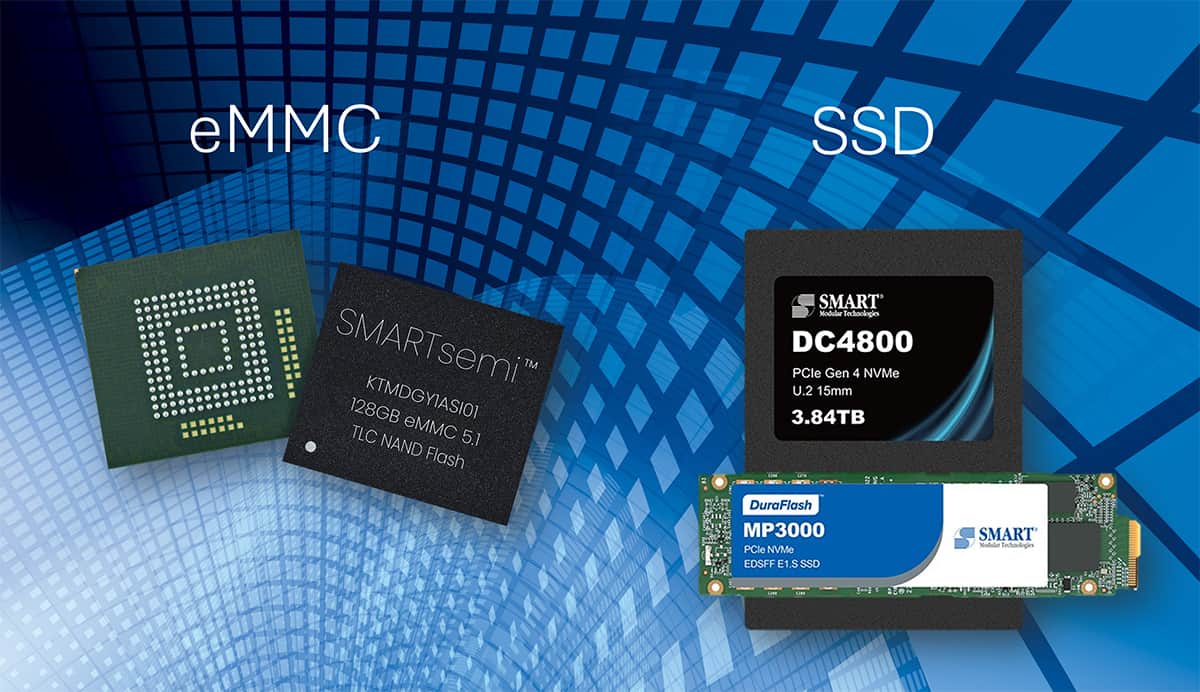Embedded Multi-Media Cards (eMMC) vs Solid-State Drives (SSD)

Solid-state drives (SSDs) and embedded Multi-Media Cards (eMMCs) both use NAND flash memory. They are found in similar electronic devices and perform similar tasks. However, the choice for an SSD or eMMC matters significantly from the design phase through the user phase and determines, among other things, the performance and price. In this blog post, we will dive deeper into the differences between SSDs and eMMCs and their respective advantages and disadvantages.
The eMMC vs SSD
The eMMC is a non-volatile memory component that is embedded, meaning that a single silicon die with both the NAND flash memory and its controller is soldered onto the motherboard. As discussed in a previous blog post, the fact that an eMMC is physically attached to the printed circuit board (PCB) is one of the main differentiators from the Secure Digital (SD) card, which is removable.
While the SD card is technically the successor of the (e)MMC, the SSD is the successor of the hard disk drive (HDD). The SSD is also a non-volatile storage device that relies on NAND flash to store persistent data. SSDs are connected to the motherboard through Serial ATA (SATA) 3, mSATA, SATA Express, or PCIe interface. SSDs are more robust than HDDs because they don’t have any moving parts that can break easily with impact.
Capacity and speed
When considering memory components, capacity is always a key characteristic. eMMCs are available in storage capacities up to 512GB, even though the marketplace primarily offers lower capacities. At SMARTsemi, our eMMC 5.1 product range spans 4 GB to 128 GB. SSDs usually only start at 128 GB and go up to several TBs. Unlike an eMMC that gets soldered onto the motherboard, an SSD is relatively easy to remove or upgrade, so expanding capacity in the host device becomes an option.
Another deciding factor when selecting memory components is speed. The SSD also ‘wins’ on that front. eMMCs (5.1) can reach a sequential read speed of up to 400 MB/s. SATA SSDs have a comparable speed performance. However, SSDs can handle much more volume at that speed simply because they can distribute read/write commands over more memory gates. With up to 20 NAND flash chips available in the SSD, its controller can spread out read and write operations optimally. This speed difference between eMMC and SSD is often compared to a highway: Even if the speed that the cars on the road can reach is the same, having only two lanes – the eMMC in this comparison, versus six lanes – a representation of the SSD, makes a big difference. Keeping in mind that the lifetime of Flash memory components is limited by the number of program/erase (P/E) cycles, eMMCs will also likely wear out faster if executing the same tasks because operations are not spread out across drives as in SSDs. The non-volatile memory express (NVMe)-based SSDs pulverize eMMC speeds at 3.5GB/s on the PCIe 3.0 standard. The PCIe 4.0 NVMe SSD is nearing double that speed. And PCIe 5.0 NVMe SSD increases read and write speeds even more.
Fit for the job
eMMCs have a few characteristics that make them particularly suitable for certain applications over SSDs. For example, eMMCs have smaller form factors and consume less power than SSDs which is very important in many long-life applications out in the field. When file sizes are smaller, the speed is not as critical, making eMMCs interesting. However, the most common reason for selecting eMMCs over SSDs is pricing: eMMCs cost significantly less per gigabyte versus SSDs. The tradeoff between cost and speed/capacity, makes eMMCs the desirable choice for many electronic systems in medical, automotive, networking, communication, home entertainment, and defense applications.
SSDs and eMMCs share several attributes but there are also clear distinctions in capacity, speed, power consumption, size, and cost that can guide engineers and procurement specialists in selecting the right component for the application. At SMARTsemi, we specialize in memory components for long-life applications. Our eMMC offering includes eMMC 5.0 wide-temperature range, automotive grade 2, as well as, commercial and industrial range eMMC 5.1. A range of SSDs for different applications are available through SMART Modular Technologies.
SMARTsemi is your supply chain partner for DRAM components, eMMC solutions, and SD/microSD Flash Memory Cards for long-life applications. With 20+ years of industry experience, we understand your challenges and have aligned our priorities with yours to simplify your memory chip supply chain for the long run. We know what you need before you need it. Get a jump start and request a sample today.






